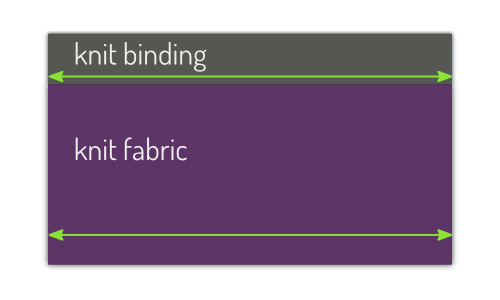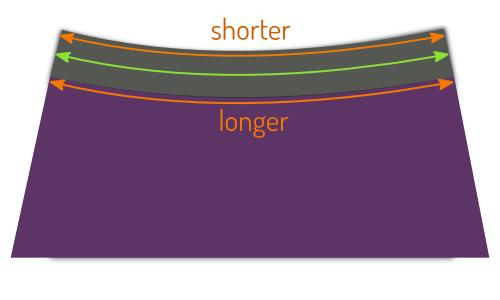What is knit binding anyway?
Knit binding is a general term for a type of finish (typically) found on the neck or arm opening of T-shirts and other knitwear.
There’s two varieties of this finish, a knit band, and actual knit binding.
Knit band

Knit band is what you typically find at the neck opening of your T-shirt. It’s a strip of fabric that is folded double and attached to the edge of the garment.
This leaves an unfinished edge on the inside that is often sewn down by edge-stitching around the knit band.
Knit binding

Real knit binding acts more like classic bias binding, in that it is wrapped around the fabric, rather than extend from it.
The raw edge of the garment is inserted between the folded knit binding, which is edge-stitched down. This is often done with a coverlock machine, thereby neatly finishing the inside.
Pictures by Support Tattoos and Piercings at Work and Derek A.
Style vs function
A knit band is more common, and is what you typically find on T-shirt necklines. It’s the more decorative option.
A knit binding is less common, but often used on undershirts (as in, underwear). It’s the more functional option.
Still confused?
Another way to distinguish them is this: Think about what happens when you decide to widen the knit binding/band.
On a T-shirt, widening the band at the neck will make the neck opening smaller. If you want a wider band, you will have to cut a larger hole in your T-shirt.
On an undershirt, if you want the knitwear binding at the neck to be wider, it will not make the neck opening smaller. Instead, the binding will simply lay further over the undershirt main fabric.
Why knitwear binding requires stretch
Whether you’re using a knit band or a knit binding finish, you are going to have to stretch your binding fabric for good results. That is, assuming you’re not sewing a straight seam. Here’s why:
Straight: life on easy mode

On a straight seam, you can simply attach your binding/band. Your fabric and binding have the same length, so everything will be fine.
The most likely scenario where you will encounter this is on the (short) sleeves of a T-shirt. Although the knit band wraps around your arm, from a pattern perspective (as in, when the fabric is still flat) it’s a straight seam.
Uniformly curved: uniform stretch

On a curved seam, like an neck opening, things get a little more complicated. That is because the outer edge and the inner edge of your binding will have a different length.
No stretch, and things won’t lie flat (aka gape)
If you simply sew the binding to the fabric, things will be fine at the outer edge of your binding. But the inner edge is shorter, and your binding fabric will be pushed together. The tension that this creates will make it rise, and your binding will not lie flat against your skin.
Stretch it just right, and it will look great
To fix this issue, you need to stretch your knit binding (and not the fabric) while attaching your binding. If you do it right, the outer edge will be stretched open a bit, while the inner edge will nicely fill out your curve and everything will lie flat.
If you stretch too much, things will wrinkle
Stretch your binding too much, and it will spring back too far, causing the main fabric to wrinkle.
Real life: variable stretch

Straight seams exist, and although I’ve never come across one, maybe uniformly curved seams exist too. But more often than not, the curvature of your seam will vary.
On a typical T-shirt neckline, the curve at the back of your neck is different from the front, and there’s probably a somewhat tighter bend behind your shoulder seam.
On a slight curve, the difference between the inner and outer edge is not so big, and a little bit of stretch is all you need. But on a tighter curve, the difference between the inner and outer edge of your binding will be more significant. And you’ll need more stretch to accommodate for that.
So as you follow your seam, and it curves around necklines, or shoulders, or design features, you will have to adapt the amount of stretch to the situation.
You cannot calculate the length of your knit binding
I am not saying it is theoretically impossible. But I am saying that it is practically impossible.
The length of your knit binding depends on the amount it needs to be stretched. This depends on the curves you have to follow, and the width of the binding, not to mention the strength of its stretchiness. There’s just too many parameters to take into account to calculate your binding length accurately.
Do not do this
There are a bunch of tutorials out on the internet that show you how to sew on knit binding. Many of those suggest something like make the neck binding 90% of the length of the seam you are attaching it to (the percentage varies).
This idea is that you cut your binding, join its edges, and then sew it in the opening. That is (in my opinion) no good.
An alternative approach to sidestep the length issue is to attach the binding before you close the opening your binding goes in. For example, on a T-shirt you close one shoulder seam, attach the binding, then close the second shoulder seam.
Obviously, that means your shoulder seam will cut through your binding which is a big no no in my book.
Instead, do this
- Cut your binding as long as the seam it needs to be sewn into. Not 90%, but 100%. This way, you know it’s going to be too long, and that’s what we want.
- Mark the place you want your binding to be joined (say center back of the neckline) and place your binding 1cm beyond this point.
- Start sewing your binding about 3cm or so from this point, and go all the way around. While you do so, make sure to adjust the stretch to whatever the curve requires. There’s no tricks for this, you’ll have to practice until it comes naturally to you.
- When you make your way around and get close to the point you marked, stop about 3cm before that.
- Now your entire binding is attached, apart from a 6cm or so stretch at the back. Pin both edges of your binding good sides together, making is exactly as long as needed and sew them together.
- Sew the remaining 6cm of your binding.
This way, there is no guessing how long your binding should be, and the binding seam sits where you want it to sit.
For detailed instructions, check the Aaron documentation
Alternate method
While the above instructions describe one way to attach a knit band or knit binding, it is not the only method that can be used. An alternate method is to cut the exact amount of binding needed, sew it into a ring, and then attach the ring to the garment opening.
Some people feel that this is an easier method for novice sewists. They are told exactly how much binding to use, and they do not have to guess how much they should be stretching the binding as they sew.
-
Measure the garment opening that the binding will cover. Be sure to measure at the seamline, to account for seam allowance.
-
Check the pattern instructions for the length of binding to use. Or, use a length 80-90% smaller than the opening based on the stretchiness of the binding fabric. (For example, 80% for very stretchy fabric, 90% for less stretchy fabric.)
-
Cut the length of binding required plus seam allowance at each end.
-
Sew the binding ends right sides together to form a closed loop or ring. Trim excess seam allowance.
-
Fold the ring together at the seam to divide the ring into equal halves. Mark or insert pins at each end fold. One pin will be in the seam, and the other will mark the halfway point around the ring.
-
Unfold the ring and fold it again into equal halves so the two marks/pins meet together in the middle. Again mark or insert pins into each end fold. Now there are 4 pins or marks dividing the ring into 4 quarters of equal length.
-
Similarly, fold the garment opening and mark or insert pins to divide the garment opening into 4 quarters of equal length.
-
Match the marks or pins on the binding with the ones on the garment opening. (Try to align it so the seam is at the most inconspicuous location in the garment opening. For example, if binding a neck opening align the binding so the seam is at the back of the neck opening.)
-
Pin the binding ring to the garment opening at each quarter mark/pin. This ensures that the binding is evenly distributed around the garment opening.
-
Sew the binding to the opening, one quarter at a time. While sewing, evenly stretch each quarter segment of binding to match the length of the quarter segment of garment opening.